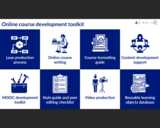
This is a series of micro-courses aimed at lecturers; they cover the basics of online course development.
- Subject:
- Education
- Educational Technology
- Material Type:
- Full Course
- Author:
- Louise Kearins @ AUT HigherEd4.0 Project
- Date Added:
- 08/28/2024

This is a series of micro-courses aimed at lecturers; they cover the basics of online course development.

Long Description:
This book serves as a companion to the Open Educational Resources: Basics & Beyond course hosted in the OCO Learning Portal. Guests may view the contents of the course, but Oklahoma faculty and staff are welcome to request an account to complete the course and earn digital credentials.
Word Count: 15067
Included H5P activities: 14
(Note: This resource's metadata has been created automatically by reformatting and/or combining the information that the author initially provided as part of a bulk import process.)

Word Count: 22091
(Note: This resource's metadata has been created automatically by reformatting and/or combining the information that the author initially provided as part of a bulk import process.)

Short Description:
This resource provides a micro-course opportunity for students to learn about, engage with, and advocate for lower textbook costs through the use of open educational resources.
Long Description:
This resource provides a micro-course opportunity for students to learn about, engage with, and advocate for lower textbook costs through the use of open educational resources. It is used at Oklahoma State University to support student advocacy for open practices; it is used in particular with students selected to the OpenOKState Student Fellows program.
Word Count: 2080
(Note: This resource's metadata has been created automatically by reformatting and/or combining the information that the author initially provided as part of a bulk import process.)

Faculty, Library, and Student Collaborations
Long Description:
The term “open” has been heavily used in the past decade or more and can come with multiple interpretations: open access, open source, open textbook, open pedagogy … In general, “open” within these contexts implies unlimited, free, public access with the ability to manipulate and transform the educational content.Within the educational realm, we see even greater nuances of “open” in terms of how the access to and adapted creation work together. Our book aims to shed light on multiple definitions and how they are applied in a variety of learning experiences.Chapters provide case studies of library-teaching faculty collaborations that explore the intersecting roles and desired outcomes that each partner contributes toward student learning in an open environment.
Word Count: 146095
(Note: This resource's metadata has been created automatically by reformatting and/or combining the information that the author initially provided as part of a bulk import process.)
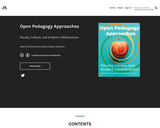
Faculty, Library, and Student Collaborations
Short Description:
Buy a print copy
Long Description:
The term “open” has been heavily used in the past decade or more and can come with multiple interpretations: open access, open source, open textbook, open pedagogy … In general, “open” within these contexts implies unlimited, free, public access with the ability to manipulate and transform the educational content.Within the educational realm, we see even greater nuances of “open” in terms of how the access to and adapted creation work together. Our book aims to shed light on multiple definitions and how they are applied in a variety of learning experiences.Chapters provide case studies of library-teaching faculty collaborations that explore the intersecting roles and desired outcomes that each partner contributes toward student learning in an open environment.
Word Count: 146386
ISBN: 978-1-942341-64-2
(Note: This resource's metadata has been created automatically by reformatting and/or combining the information that the author initially provided as part of a bulk import process.)

Word Count: 5125
Included H5P activities: 3
(Note: This resource's metadata has been created automatically by reformatting and/or combining the information that the author initially provided as part of a bulk import process.)
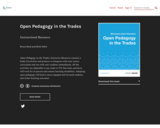
Instructional Resource
Short Description:
Open Pedagogy in the Trades: Instructor Resource contains a bank of activities and projects to integrate with your course curriculum and use with your students immediately. All the activities are adaptable to any trade or ITA line item, and most will work for in-person and remote learning modalities. Adopting open pedagogy will lead to more engaged and invested students and richer learning outcomes.
Long Description:
Open Pedagogy in the Trades: Instructor Resource contains a bank of activities and projects to integrate with your course curriculum and use with your students immediately. All the activities are adaptable to any trade or ITA line item, and most will work for in-person or remote learning modalities. Adopting open pedagogy will lead to more engaged and invested students and richer learning outcomes.
Word Count: 4219
ISBN: 978-1-77420-093-3
(Note: This resource's metadata has been created automatically by reformatting and/or combining the information that the author initially provided as part of a bulk import process.)
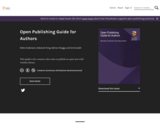
Short Description:
This guide is for creators who want to publish an open text with UniSQ Library.
Long Description:
The UniSQ Open Publishing Guide is for those who want to publish an open text with the UniSQ Library. It steps authors through the process they will undertake when working with the UniSQ Open Educational Practices Team, and sets out guidelines and expectations for the undertaking.
It covers: Planning an open publication: guiding principles and considerations Preparing your manuscript: style and licence requirements; keeping track of your project; inclusivity and accessibility; creating your manuscript; academic integrity; and quality and peer review Working with the UniSQ Open Educational Practices Team: the role of authors, and the role of the UniSQ Open Educational Practices Team. Writing and designing your open text Promoting and evaluating the impact of your open text.
While this book was adapted specifically for a UniSQ audience, others may find it useful as a resource to refer to, or to adopt or adapt for their own contexts.
Word Count: 28462
ISBN: 978-0-6453261-9-2
(Note: This resource's metadata has been created automatically by reformatting and/or combining the information that the author initially provided as part of a bulk import process.)
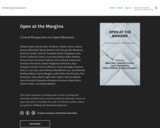
Critical Perspectives on Open Education
Short Description:
This book represents a starting point towards curating and centering marginal voices and non-dominant epistemic stances in open education. It includes the work of 43 diverse authors whose perspectives challenge the dominant hegemony.
Long Description:
Open education is at a critical juncture. It has moved on from its northern roots and is increasingly being challenged from its own periphery. At the same time, it finds itself marginalised and under threat in an educational sector infiltrated by corporate interests. However, rather than bunkering down, becoming blinkered or even complacent, the editors of this volume believe that the voices from the periphery should be amplified. This book represents a starting point towards curating and centering marginal voices and non-dominant epistemic stances in open education, an attempt at critical pluriversalism. It is a curated collection of 38 blog posts, lectures, talks, articles, and other informal works contributed by 43 diverse authors/co-authors and published since 2013. Each of these contributions offers a perspective on open education that can be considered marginal and that challenges the dominant hegemony.
Word Count: 3186
(Note: This resource's metadata has been created automatically by reformatting and/or combining the information that the author initially provided as part of a bulk import process.)

Critical Perspectives on Open Education
Short Description:
This book represents a starting point towards curating and centering marginal voices and non-dominant epistemic stances in open education. It includes the work of 43 diverse authors whose perspectives challenge the dominant hegemony.
Long Description:
Open education is at a critical juncture. It has moved on from its northern roots and is increasingly being challenged from its own periphery. At the same time, it finds itself marginalised and under threat in an educational sector infiltrated by corporate interests. However, rather than bunkering down, becoming blinkered or even complacent, the editors of this volume believe that the voices from the periphery should be amplified. This book represents a starting point towards curating and centering marginal voices and non-dominant epistemic stances in open education, an attempt at critical pluriversalism. It is a curated collection of 38 blog posts, lectures, talks, articles, and other informal works contributed by 43 diverse authors/co-authors and published since 2013. Each of these contributions offers a perspective on open education that can be considered marginal and that challenges the dominant hegemony.
Word Count: 3186
(Note: This resource's metadata has been created automatically by reformatting and/or combining the information that the author initially provided as part of a bulk import process.)

Critical Perspectives on Open Education
Short Description:
This book represents a starting point towards curating and centering marginal voices and non-dominant epistemic stances in open education. It includes the work of 43 diverse authors whose perspectives challenge the dominant hegemony.
Long Description:
Open education is at a critical juncture. It has moved on from its northern roots and is increasingly being challenged from its own periphery. At the same time, it finds itself marginalised and under threat in an educational sector infiltrated by corporate interests. However, rather than bunkering down, becoming blinkered or even complacent, the editors of this volume believe that the voices from the periphery should be amplified. This book represents a starting point towards curating and centering marginal voices and non-dominant epistemic stances in open education, an attempt at critical pluriversalism. It is a curated collection of 38 blog posts, lectures, talks, articles, and other informal works contributed by 43 diverse authors/co-authors and published since 2013. Each of these contributions offers a perspective on open education that can be considered marginal and that challenges the dominant hegemony.
Word Count: 3186
(Note: This resource's metadata has been created automatically by reformatting and/or combining the information that the author initially provided as part of a bulk import process.)
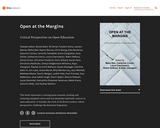
Critical Perspectives on Open Education
Short Description:
This book represents a starting point towards curating and centering marginal voices and non-dominant epistemic stances in open education. It includes the work of 43 diverse authors whose perspectives challenge the dominant hegemony.
Long Description:
Open education is at a critical juncture. It has moved on from its northern roots and is increasingly being challenged from its own periphery. At the same time, it finds itself marginalised and under threat in an educational sector infiltrated by corporate interests. However, rather than bunkering down, becoming blinkered or even complacent, the editors of this volume believe that the voices from the periphery should be amplified. This book represents a starting point towards curating and centering marginal voices and non-dominant epistemic stances in open education, an attempt at critical pluriversalism. It is a curated collection of 38 blog posts, lectures, talks, articles, and other informal works contributed by 43 diverse authors/co-authors and published since 2013. Each of these contributions offers a perspective on open education that can be considered marginal and that challenges the dominant hegemony.
Word Count: 83220
ISBN: 978-1-989014-22-6
(Note: This resource's metadata has been created automatically by reformatting and/or combining the information that the author initially provided as part of a bulk import process.)

Word Count: 18990
ISBN: 978-1-911669-23-4
(Note: This resource's metadata has been created automatically by reformatting and/or combining the information that the author initially provided as part of a bulk import process.)
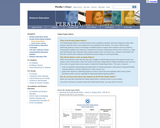
The Peralta CC District developed an Equity Rubric instrument designed to help online instructors make the learning experience more equitable for all students. The rubric’s criteria is roughly aligned with the CVC-OEI Course Design Rubric. It includes strategies to increase students’ access to technology and different types of support (both academic and non-academic); and make explicit the instructor’s commitment to inclusion by addressing some design principles through an equity lens.

The Peralta CC District developed an Equity Rubric instrument designed to help online instructors make the learning experience more equitable for all students. The rubric’s criteria is roughly aligned with the CVC-OEI Course Design Rubric. It includes strategies to increase students’ access to technology and different types of support (both academic and non-academic); and make explicit the instructor’s commitment to inclusion by addressing some design principles through an equity lens.

Little Known Facts
Short Description:
Our story is part of Canadian online distance education history.
Long Description:
We are the pioneers of the SciTech BBS / ISP. An Internet educational BBS for students, educators, and global community that was created in 1993 and ordered closed in 1999 by the institutional elite. This is my micro memoir about an innovative online distance education experiment in Canada.
Word Count: 10268
(Note: This resource's metadata has been created automatically by reformatting and/or combining the information that the author initially provided as part of a bulk import process.)

A reference for setting up an open textbook print-on-demand service
Short Description:
The Print-on-Demand Guide provides an overview for post-secondary institutions interested in offering on-demand and pre-order printing services for open textbooks and other OER. Discussions on why offering a print option enhances learning accessibility for some students are included, as well as, templates that can be used to take inventory of open educational activity and interest on campus.
Long Description:
The Print-on-Demand Guide provides an overview for post-secondary institutions interested in offering on-demand and pre-order printing services for open textbooks. In addition to being an instruction manual, various templates in this guide can be used as tools for taking inventory of open educational activity and interest on campus. For post-secondary institutions interested in expanding student accessibility to learning, information on personal preference, limited computer and internet availability, learning needs, literacy, and accessibility in general provides background on why to offer a print option for course materials.
The guide is laid out in four parts and covers the history behind print on demand; situations when printing open textbooks is warranted; reasons why an on-campus print-on-demand service benefits the post-secondary community; suggestions, considerations, and templates for setting up a print-on-demand service. Chapters include research, real-life examples, and quotes from bookstores, printshops, and libraries.
Word Count: 13836
ISBN: 978-1-77420-069-8
(Note: This resource's metadata has been created automatically by reformatting and/or combining the information that the author initially provided as part of a bulk import process.)

Short Description:
This collection features essays, case studies, and pedagogical approaches that explore how educators managed the privacy, security, and safety concerns that rushed into our lives as we shifted into emergency remote learning in 2020. While the COVID-19 pandemic brought this concern into focus, privacy issues with online learning continue to exist alongside us and our students. This book provides readers insight into the current state of privacy issues, describes the challenges and rewards of developing more privacy-focused learning environments, and presents several resources and tools that readers can bring to their own teaching practices.Representing a variety of perspectives from K-12, higher education, and libraries, contributors describe the challenges they encountered and offer solutions to help ensure the safekeeping of students’ online lives. How do we navigate these online environments, who collects our data, and how can we protect our most vulnerable populations?
Long Description:
This collection features essays, case studies, and pedagogical approaches that explore how educators managed the privacy, security, and safety concerns that rushed into our lives as we shifted into emergency remote learning in 2020. While the COVID-19 pandemic brought this concern into focus, privacy issues with online learning continue to exist alongside us and our students.
This book provides readers insight into the current state of privacy issues, describes the challenges and rewards of developing more privacy-focused learning environments, and presents several resources and tools that readers can bring to their own teaching practices.
Representing a variety of perspectives from K-12, higher education, and libraries, contributors describe the challenges they encountered and offer solutions to help ensure the safekeeping of students’ online lives. How do we navigate these online environments, who collects our data, and how can we protect our most vulnerable populations?
This platform is the Web book. For PDF and print copies, https://openpress.mtsu.edu/index.php/mtop/catalog/book/onlinelearning.
Word Count: 83213
ISBN: 979-8-9871721-0-0
(Note: This resource's metadata has been created automatically by reformatting and/or combining the information that the author initially provided as part of a bulk import process.)

Short Description:
This style guide is for authors publishing with RMIT Open Press using the Pressbooks platform. It sets out requirements for writing style, diversity, accessibility, acknowledging sources, and using figures, tables and embedded media. While the guide has been written for RMIT authors, it may provide a useful starting point for others wanting to publish open resources. The RMIT Open Press Style Guide is a companion to the RMIT Open Publishing Toolkit for Authors.
Long Description:
This style guide is for authors publishing with RMIT Open Press using the Pressbooks platform. It sets out requirements for writing style, diversity, accessibility, acknowledging sources, and using figures, tables and embedded media. While the guide has been written for RMIT authors, it may provide a useful starting point for others wanting to publish open resources. The RMIT Open Press Style Guide is a companion to the RMIT Open Publishing Toolkit for Authors.
Word Count: 6982
(Note: This resource's metadata has been created automatically by reformatting and/or combining the information that the author initially provided as part of a bulk import process.)